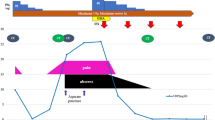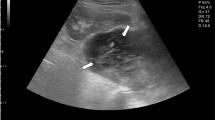Abstract
Aseptic abscesses syndrome (AA) is an emerging clinicopathological entity characterized by visceral sterile collections of mature neutrophils that do not respond to antibiotics but regress quickly when treated with corticosteroids. Although most previous case reports of AA have been restricted to Europe, we present here a Japanese woman with AA showing recurrence of splenic abscesses, ileocolitis, pyoderma gangrenosum, and arthritis. Although both steroid therapy and tumor necrosis factor (TNF)-alpha blockade were effective, relapses remained frequent.





Similar content being viewed by others
References
Andre M, Aumaitre O, Marcheix JC, et al. Aseptic systemic abscesses preceding diagnosis of Crohn’s disease by three years. Dig Dis Sci. 1995;40:525–7.
Andre MF, Piette JC, Kemeny JL, et al. Aseptic abscesses: a study of 30 patients with or without inflammatory bowel diseases and review of the literature. Medicine. 2007;86:145–61.
Fukuhara K, Urano Y, Kimura S, Hori K, Arase S. Pyoderma gangrenosum with rheumatoid arthritis and pulmonary aseptic abscesses responding to treatment with dapsone. Br J Dermatol. 1998;139:556–8.
Kasuga I, Yanagisawa N, Takeo C, Koga M, Kiyosawa H, Yonemaru M, et al. Multiple pulmonary nodules in association with pyoderma gangrenosum. Respir Med. 1997;91:493–5.
Tamura M, Nakamura M, Fukasawa M, Yamato S, Mishima W, Yuhki K. A case of pyoderma gangrenosum around an epidural catheter. J Jpn Soc Clin Anesth (in Japanese, abstract in English). 2007;27:55–60.
Ohata C, Itami S, Yoshikawa K. Pyoderma gangrenosum with pulmonary aseptic abscess. Skin Res (in Japanese, abstract in English). 2005;4:542–7.
Miller J, Yentzer BA, Clark A, Jorizzo JL, Feldman SR. Pyoderma gangrenosum: a review and update on new therapies. J Am Acad Dermatol. 2010;62:646–54.
Perin-Biroulet L, Deltenre P, de Suray N, Branche J, Sandborn WJ, Colombel JF. Efficacy and safety of tumor necrosis factor antagonists in Crohn’s disease: meta-analysis of placebo-controlled trials. Clin Gastroenterol Hepatol. 2008;6:644–53.
Samuel J, Ozen S. Familial Mediterranean fever and the other autoinflammatory syndromes: evaluation of the patient with recurrent fever. Curr Opin Rheumatol. 2006;18:108–17.
Villani AC, Lemire M, Fortin G, Louis E, Silverberg MS, Collette C, et al. Common variants in the NLRP3 region contribute to Crohn’s disease susceptibility. Nat Genet. 2009;18:71–6.
Andre MF, Aumaitre O, Grateau G, Chamaillard M, Costedoat-Charlumeau N, Cardoso MC, et al. Longest form of CCTG microsatellite repeat in the promoter of the CD2BP1/PSTPIP1 gene is associated with aseptic abscesses and with Crohn disease in French patients. Dig Dis Sci. 2010;55:1681–8.
Conflict of interest
None.
Author information
Authors and Affiliations
Corresponding author
About this article
Cite this article
Ito, T., Sato, N., Yamazaki, H. et al. A case of aseptic abscesses syndrome treated with corticosteroids and TNF-alpha blockade. Mod Rheumatol 23, 195–199 (2013). https://doi.org/10.1007/s10165-012-0640-y
Received:
Accepted:
Published:
Issue Date:
DOI: https://doi.org/10.1007/s10165-012-0640-y




